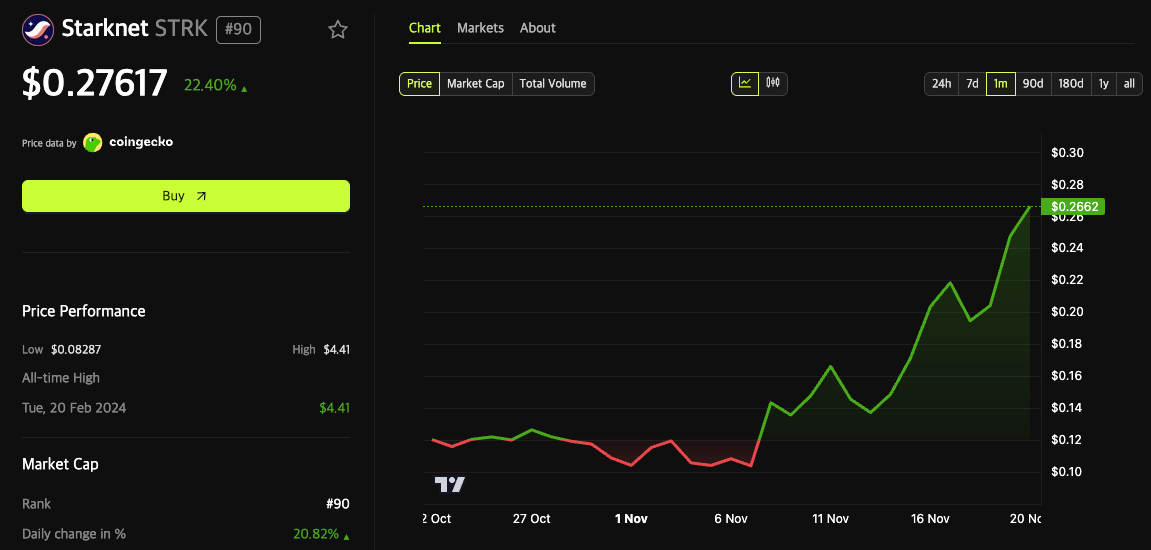Starknet’s native token, STRK, rallied above $0.27, ending a 300-day accumulation phase, and daily trading volume surpassed $1 billion. Anchorage Digital’s support for Bitcoin staking on Starknet has sparked new institutional interest, with more than $300 million in assets now securing the network.
This breakout marks a turning point for the Layer-2 protocol, driven by increased staking demand and renewed interest in Zcash’s privacy innovations. However, pending token unlocks may test whether accumulation momentum withstands potential sell pressure.
SponsoredInstitutional Support Unlocks New Staking Era
Anchorage Digital, a federally chartered digital asset bank, began supporting Bitcoin staking on Starknet in November 2025. Earlier in September, it became the first qualified custodian to offer institutional-grade custody and staking for STRK. This enables institutions to earn rewards and boost network security using regulated infrastructure.
Starknet now reports more than $300 million in value, securing the consensus mechanism. As of November 2025, 920 million STRK and over 1,260 Bitcoin are actively staked. This shift from retail to institutional participation could help stabilize price swings and increase decentralization.
Anchorage’s Bitcoin staking builds on its November 2024 integration with the Babylon protocol, which pioneered institutional BTC staking. Expanding to Starknet reflects a growing desire for yield across blockchains. Meanwhile, the BTCFi initiative launched in September 2025, setting aside 100 million STRK in incentives for Bitcoin staking and DeFi, positioning Starknet for growth in Bitcoin-based finance.
By combining regulated custody with trustless staking, Starknet addresses institutional fears about security and compliance. This infrastructure could bring capital from traditional finance players who have previously been hesitant about Layer-2 protocols.
Price Breakout Fueled by Accumulation and Zcash Narrative
According to BeInCrypto info, STRK traded at $0.27617 as of 5:00 am UTC, surging 22.4% in 24 hours and 98% over the previous month. The token’s market cap reached $1.26 billion, with 4.56 billion STRK circulating out of a maximum supply of 10 billion. Daily trading volume surpassed $1 billion as STRK exited its 300-day consolidation.
Sponsored
This price movement coincides with a narrative linking Starknet to Zcash‘s privacy history. Eli Ben-Sasson, co-founder of both Zcash and StarkWare, has led the adoption of zero-knowledge proofs for over a decade. His 2013 Bitcoin conference presentation on zero-knowledge proofs spurred industry research into scaling and privacy. Now, Starknet’s STARK proofs deliver on-chain privacy reminiscent of Zcash, but now in a Layer-2 environment.
Analysts call this the “Ztarknet” thesis, with Starknet seen as Zcash’s successor, evolving on-chain privacy into programmable use. A 35% daily STRK spike on speculation appeared about this narrative. As Zcash sees renewed attention, some anticipate comparable price action for STRK. Community sentiment is bullish, with 82% of CoinGecko users expressing optimism.
Capital inflows have been high, giving Starknet the second-largest net flows among Layer-1 and Layer-2 chains after Arbitrum. Volume reached $832 million during mid-November’s peak. The token trades well below its $4.42 all-time high from February 2024, leaving room for growth if momentum continues.
SponsoredStaking Demand Counters Token Unlock Concerns
Historically, token unlocks have pressured cryptocurrency prices. CryptoRank data shows that 90% of unlocks coincide with price drops. Starknet faces weekly unlocks, adding around $18.9 million STRK (about 2% of supply) monthly. The protocol raised $282.5 million in nine funding rounds, according to ICO Drops, with vesting through 2025 and beyond.
Still, on-chain trends show that staking demand can support the price. After a recent unlock, 30 million STRK were staked instead of sold, according to community analysis. The total staked reached 921.6 million STRK (worth $202.73 million), about 20.21% of the supply as of November 2025. A 4.5% increase in staking after the unlock reveals that many holders prefer long-term participation over quick profits.
The staking rate above 20% is high for Layer-2 protocols. It signals conviction among holders, in contrast to typical unlocks, where swift selling is common. Institutional staking tools from Anchorage also support this trend, as institutions usually plan for the long term.
SponsoredSustained staking growth could limit the circulating supply if demand accelerates. With only 4.56 billion of 10 billion tokens circulating and over 920 million staked, the liquid supply is low. If institutional interest continues to rise, less selling and higher demand could push STRK closer to the $2 target set by some analysts.
Network Security and Market Outlook
More than $300 million staked on Starknet has significantly increased its security. The protocol uses both STRK and Bitcoin for staking, aligning incentives between Starknet and Bitcoin holders. This dual-token approach distinguishes Starknet from Layer-2 projects that rely solely on Ethereum.
STRK trades on major exchanges like Binance, OKX, and KuCoin, with the STRK/USDT pair being the most active. It ranks 90th by market cap, placing it among the top Layer-2 tokens. Ongoing institutional adoption and growing staking could move STRK into the top 50, especially as it captures Bitcoin-based DeFi activity.
Technical analysts note that Zcash (ZEC) had multiple 500% rallies in earlier cycles. If STRK mimics this from $0.27, the $2 target equals a more than 600% gain. Realizing such gains hinges on continued accumulation, effective integration of Bitcoin staking, and favorable overall market trends.
The weeks ahead will reveal if Starknet’s fundamentals can sustain higher prices. Token unlock schedules, ongoing institutional engagement, and general crypto market performance will influence whether this breakout becomes a prolonged rally. With more than 1,260 Bitcoin and 920 million STRK staked, Starknet is positioned to compete among Layer-2 protocols, attracting institutional capital.

